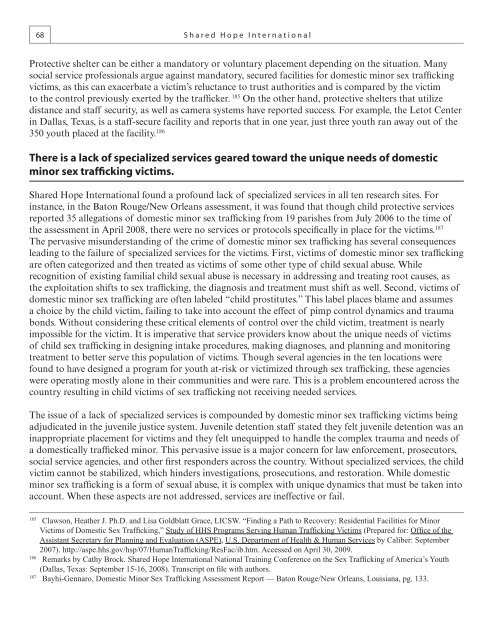By Linda A Smith Samantha Healy Vardaman Melissa A Snow
The National Report on Domestic Minor Sex Trafficking
The National Report on Domestic Minor Sex Trafficking
You also want an ePaper? Increase the reach of your titles
YUMPU automatically turns print PDFs into web optimized ePapers that Google loves.
68Shared Hope InternationalProtective shelter can be either a mandatory or voluntary placement depending on the situation. Manysocial service professionals argue against mandatory, secured facilities for domestic minor sex traffickingvictims, as this can exacerbate a victim’s reluctance to trust authorities and is compared by the victimto the control previously exerted by the trafficker. 185 On the other hand, protective shelters that utilizedistance and staff security, as well as camera systems have reported success. For example, the Letot Centerin Dallas, Texas, is a staff-secure facility and reports that in one year, just three youth ran away out of the350 youth placed at the facility. 186There is a lack of specialized services geared toward the unique needs of domesticminor sex trafficking victims.Shared Hope International found a profound lack of specialized services in all ten research sites. Forinstance, in the Baton Rouge/New Orleans assessment, it was found that though child protective servicesreported 35 allegations of domestic minor sex trafficking from 19 parishes from July 2006 to the time ofthe assessment in April 2008, there were no services or protocols specifically in place for the victims. 187The pervasive misunderstanding of the crime of domestic minor sex trafficking has several consequencesleading to the failure of specialized services for the victims. First, victims of domestic minor sex traffickingare often categorized and then treated as victims of some other type of child sexual abuse. Whilerecognition of existing familial child sexual abuse is necessary in addressing and treating root causes, asthe exploitation shifts to sex trafficking, the diagnosis and treatment must shift as well. Second, victims ofdomestic minor sex trafficking are often labeled “child prostitutes.” This label places blame and assumesa choice by the child victim, failing to take into account the effect of pimp control dynamics and traumabonds. Without considering these critical elements of control over the child victim, treatment is nearlyimpossible for the victim. It is imperative that service providers know about the unique needs of victimsof child sex trafficking in designing intake procedures, making diagnoses, and planning and monitoringtreatment to better serve this population of victims. Though several agencies in the ten locations werefound to have designed a program for youth at-risk or victimized through sex trafficking, these agencieswere operating mostly alone in their communities and were rare. This is a problem encountered across thecountry resulting in child victims of sex trafficking not receiving needed services.The issue of a lack of specialized services is compounded by domestic minor sex trafficking victims beingadjudicated in the juvenile justice system. Juvenile detention staff stated they felt juvenile detention was aninappropriate placement for victims and they felt unequipped to handle the complex trauma and needs ofa domestically trafficked minor. This pervasive issue is a major concern for law enforcement, prosecutors,social service agencies, and other first responders across the country. Without specialized services, the childvictim cannot be stabilized, which hinders investigations, prosecutions, and restoration. While domesticminor sex trafficking is a form of sexual abuse, it is complex with unique dynamics that must be taken intoaccount. When these aspects are not addressed, services are ineffective or fail.185Clawson, Heather J. Ph.D. and Lisa Goldblatt Grace, LICSW. “Finding a Path to Recovery: Residential Facilities for MinorVictims of Domestic Sex Trafficking,” Study of HHS Programs Serving Human Trafficking Victims (Prepared for: Office of theAssistant Secretary for Planning and Evaluation (ASPE), U.S. Department of Health & Human Services by Caliber: September2007). http://aspe.hhs.gov/hsp/07/HumanTrafficking/ResFac/ib.htm. Accessed on April 30, 2009.186Remarks by Cathy Brock. Shared Hope International National Training Conference on the Sex Trafficking of America’s Youth(Dallas, Texas: September 15-16, 2008). Transcript on file with authors.187Bayhi-Gennaro, Domestic Minor Sex Trafficking Assessment Report — Baton Rouge/New Orleans, Louisiana, pg. 133.
















